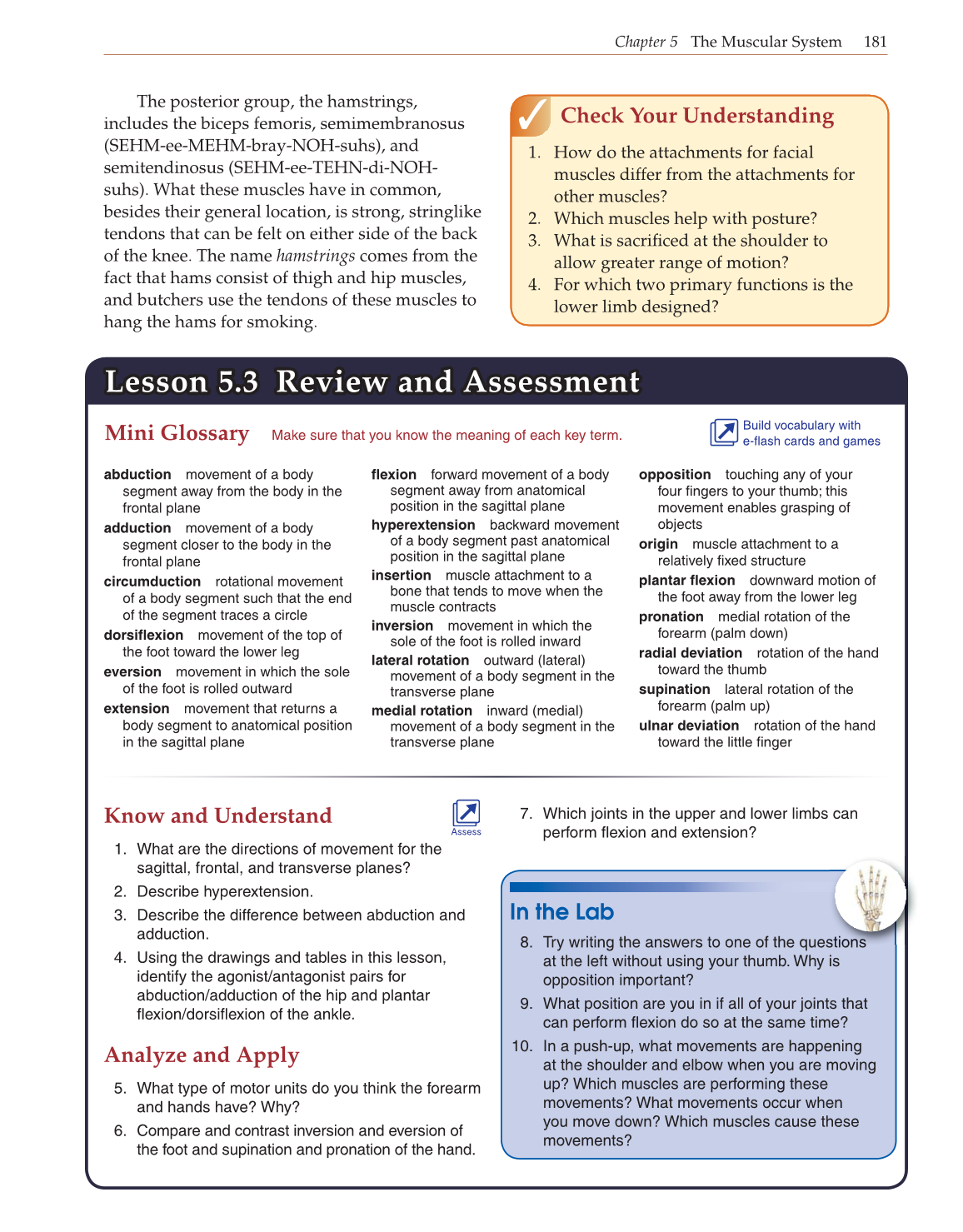Chapter 5 The Muscular System 181
Lesson 5.3 Review and Assessment Lesson 5.3 Review and Assessment
Mini Glossary
Make sure that you know the meaning of each key term.
ab duction movement of a body
segment away from the body in the
frontal plane
ad duction movement of a body
segment closer to the body in the
frontal plane
circum duction rotational movement
of a body segment such that the end
of the segment traces a circle
dorsi fl exion movement of the top of
the foot toward the lower leg
e version movement in which the sole
of the foot is rolled outward
ex tension movement that returns a
body segment to anatomical position
in the sagittal plane
fl exion forward movement of a body
segment away from anatomical
position in the sagittal plane
hyperex tension backward movement
of a body segment past anatomical
position in the sagittal plane
in sertion muscle attachment to a
bone that tends to move when the
muscle contracts
in version movement in which the
sole of the foot is rolled inward
lateral r otation outward (lateral)
movement of a body segment in the
transverse plane
medial r otation inward (medial)
movement of a body segment in the
transverse plane
opp osition touching any of your
four fi ngers to your thumb; this
movement enables grasping of
objects
origin muscle attachment to a
relatively fi xed structure
plantar fl exion downward motion of
the foot away from the lower leg
pr onation medial rotation of the
forearm (palm down)
radial de viation rotation of the hand
toward the thumb
sup ination lateral rotation of the
forearm (palm up)
ulnar de viation rotation of the hand
toward the little fi nger
Know and Understand
1. What are the directions of movement for the
sagittal, frontal, and transverse planes?
2. Describe hyperextension.
3. Describe the difference between abduction and
adduction.
4. Using the drawings and tables in this lesson,
identify the agonist/antagonist pairs for
abduction/adduction of the hip and plantar
fl exion/dorsifl exion of the ankle.
Analyze and Apply
5. What type of motor units do you think the forearm
and hands have? Why?
6. Compare and contrast inversion and eversion of
the foot and supination and pronation of the hand.
7. Which joints in the upper and lower limbs can
perform fl exion and extension?
8. Try writing the answers to one of the questions
at the left without using your thumb. Why is
opposition important?
9. What position are you in if all of your joints that
can perform fl exion do so at the same time?
10. In a push-up, what movements are happening
at the shoulder and elbow when you are moving
up? Which muscles are performing these
movements? What movements occur when
you move down? Which muscles cause these
movements?
In the Lab
stions
Assess
Build vocabulary with
e-fl ash cards and games
The posterior group, the hamstrings,
includes the biceps femoris, semimembranosus
(SEHM-ee-MEHM-bray-NOH-suhs), and
semitendinosus (SEHM-ee-TEHN-di-NOH-
suhs). What these muscles have in common,
besides their general location, is strong, stringlike
tendons that can be felt on either side of the back
of the knee. The name hamstrings comes from the
fact that hams consist of thigh and hip muscles,
and butchers use the tendons of these muscles to
hang the hams for smoking.
1. How do the attachments for facial
muscles differ from the attachments for
other muscles?
2. Which muscles help with posture?
3. What is sacrifi ced at the shoulder to
allow greater range of motion?
4. For which two primary functions is the
lower limb designed?
Check Your Understanding
